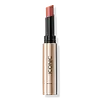What's inside
What's inside
 Key Ingredients
Key Ingredients

 Benefits
Benefits

 Concerns
Concerns

 Ingredients Side-by-side
Ingredients Side-by-side

Diisostearyl Malate
EmollientPhytosteryl/Isostearyl/Cetyl/Stearyl/Behenyl Dimer Dilinoleate
Skin ConditioningHydrogenated Polyisobutene
EmollientPolyglyceryl-2 Triisostearate
EmulsifyingBis-Diglyceryl Polyacyladipate-2
EmollientCeresin
Emulsion StabilisingMenthyl Lactate
MaskingMicrocrystalline Wax
Emulsion StabilisingAluminum Hydroxide
EmollientArgania Spinosa Kernel Oil
EmollientMangifera Indica Seed Butter
Skin ConditioningPersea Gratissima Oil
Skin ConditioningButyrospermum Parkii Butter
Skin ConditioningHydrogenated Vegetable Oil
EmollientTocopherol
AntioxidantCI 77491
Cosmetic ColorantCI 77891
Cosmetic ColorantCI 15850
Cosmetic ColorantCI 19140
Cosmetic ColorantCI 42090
Cosmetic ColorantDiisostearyl Malate, Phytosteryl/Isostearyl/Cetyl/Stearyl/Behenyl Dimer Dilinoleate, Hydrogenated Polyisobutene, Polyglyceryl-2 Triisostearate, Bis-Diglyceryl Polyacyladipate-2, Ceresin, Menthyl Lactate, Microcrystalline Wax, Aluminum Hydroxide, Argania Spinosa Kernel Oil, Mangifera Indica Seed Butter, Persea Gratissima Oil, Butyrospermum Parkii Butter, Hydrogenated Vegetable Oil, Tocopherol, CI 77491, CI 77891, CI 15850, CI 19140, CI 42090
Polybutene
Octyldodecanol
EmollientHydrogenated Polydecene
EmollientSynthetic Wax
AbrasiveHydrogenated Styrene/Isoprene Copolymer
Cera Microcristallina
Emulsion StabilisingAroma
Helianthus Annuus Seed Oil
EmollientSilica
AbrasiveEuterpe Oleracea Fruit Oil
Skin ConditioningPentaerythrityl Tetra-Di-T-Butyl Hydroxyhydrocinnamate
AntioxidantTocopheryl Acetate
AntioxidantMica
Cosmetic ColorantTocopherol
AntioxidantCocoyl Hydrolyzed Collagen
CleansingEthylene/Propylene Copolymer
AbrasiveDisteardimonium Hectorite
StabilisingPolyhydroxystearic Acid
EmulsifyingCI 77891
Cosmetic ColorantCI 77491
Cosmetic ColorantCI 42090
Cosmetic ColorantCI 77163
Cosmetic ColorantCI 19140
Cosmetic ColorantCI 77742
Cosmetic ColorantCI 15850
Cosmetic ColorantCI 15985
Cosmetic ColorantCI 45410
Cosmetic ColorantCI 73360
Cosmetic ColorantPolybutene, Octyldodecanol, Hydrogenated Polydecene, Synthetic Wax, Hydrogenated Styrene/Isoprene Copolymer, Cera Microcristallina, Aroma, Helianthus Annuus Seed Oil, Silica, Euterpe Oleracea Fruit Oil, Pentaerythrityl Tetra-Di-T-Butyl Hydroxyhydrocinnamate, Tocopheryl Acetate, Mica, Tocopherol, Cocoyl Hydrolyzed Collagen, Ethylene/Propylene Copolymer, Disteardimonium Hectorite, Polyhydroxystearic Acid, CI 77891, CI 77491, CI 42090, CI 77163, CI 19140, CI 77742, CI 15850, CI 15985, CI 45410, CI 73360
Ingredients Explained
These ingredients are found in both products.
Ingredients higher up in an ingredient list are typically present in a larger amount.
Ci 15850 is the pigment color red. It is an azo dye and created synthetically.
Azo dyes need to be thoroughly purified before use. This allows them to be more stable and longer-lasting.
This ingredient is common in foundations, lipsticks, and blushes. This color is described as brown/orangey red.
It has many secondary names such as Red 6 and Red 7. According to a manufacturer, Red 6 usually contains aluminum.
Learn more about CI 15850CI 19140 is also known as Tartrazine. Tartrazine is a synthetic dye used in cosmetics, foods, and medicine to add a yellow color.
Tartrazine is created from petroleum and is water-soluble.
Some people may experience allergies from this dye, especially asthmatics and those with an aspirin intolerance.
Learn more about CI 19140Ci 42090 is a synthetic dye created from petroleum. It is used to give a bright blue color to cosmetics, medicine, and food.
Ci 77491 is also hydrated iron III oxide. It's sole purpose is to give a red/pink hue to products.
Iron III oxides are classified as inorganic chemicals for coloring.
Synthetically created Ci 77491 is considered safer than those naturally found. This is because the synthetically created version may contain less impurities. Iron oxides are generally non-toxic and non-allergenic.
Learn more about CI 77491Ci 77891 is a white pigment from Titanium dioxide. It is naturally found in minerals such as rutile and ilmenite.
It's main function is to add a white color to cosmetics. It can also be mixed with other colors to create different shades.
Ci 77891 is commonly found in sunscreens due to its ability to block UV rays.
Learn more about CI 77891Tocopherol (also known as Vitamin E) is a common antioxidant used to help protect the skin from free-radicals and strengthen the skin barrier. It's also fat soluble - this means our skin is great at absorbing it.
Vitamin E also helps keep your natural skin lipids healthy. Your lipid skin barrier naturally consists of lipids, ceramides, and fatty acids. Vitamin E offers extra protection for your skin’s lipid barrier, keeping your skin healthy and nourished.
Another benefit is a bit of UV protection. Vitamin E helps reduce the damage caused by UVB rays. (It should not replace your sunscreen). Combining it with Vitamin C can decrease sunburned cells and hyperpigmentation after UV exposure.
You might have noticed Vitamin E + C often paired together. This is because it is great at stabilizing Vitamin C. Using the two together helps increase the effectiveness of both ingredients.
There are often claims that Vitamin E can reduce/prevent scarring, but these claims haven't been confirmed by scientific research.
Learn more about Tocopherol